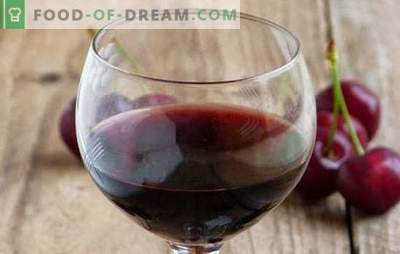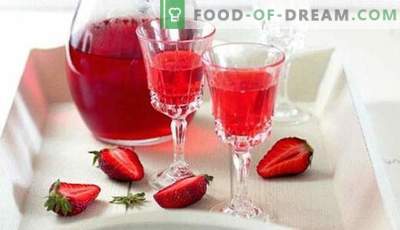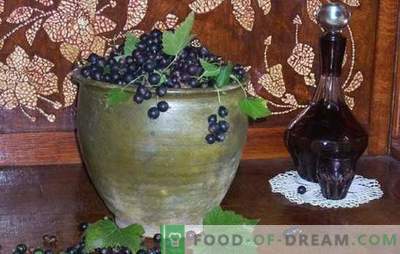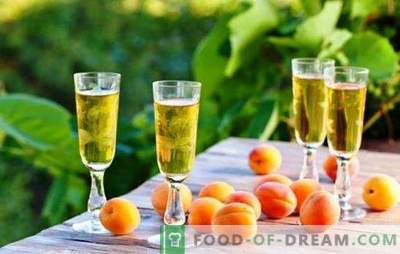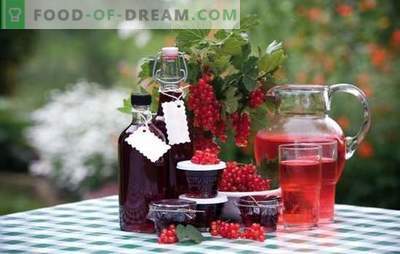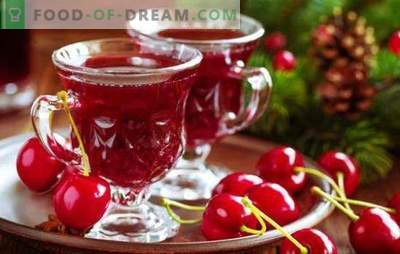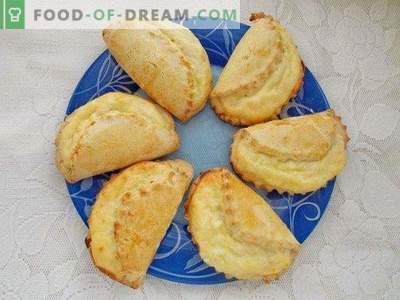- Wine from grapes at home - general manufacturing principles
- Necessary equipment and inventory for the manufacture and storage of wine from grapes at home
- Storing grape wine at home
- Quality factors for homemade wine
- The main stages of making wine from grapes at home
- Recipe 1. Wine from grapes at home, dry, red
- Recipe 2. Wine from grapes at home “Isabella”, dry, red, vintage
- Recipe 3. Wine from grapes at home “Lydia”, dry, white, vintage
- Recipe 4. Wine from grapes at home blended, semi-sweet, nutmeg
- Recipe 5. Homemade wine made from grapes is Magyar strong with raisins
- Recipe 6. Wine from grapes at home red, strong "Kagor"
- Recipe 7. Wine from grapes at home, white vermouth, classic
- Recipe 8. Wine from grapes at home, vermouth red, classic
- Recipe 9. Wine from grapes at home: sparkling, semi-dry, pink, nutmeg
- Recipe 10. Wine from grapes at home “Port”
- Recipe 11. Chach from grapes at home
- Wine from grapes at home - tricks and tips
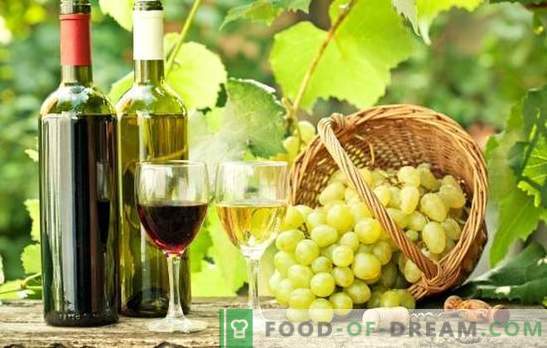
Currently there are more than 4,500 names in the world of famous wines only.
And how many unique recipes of wine from grapes hidden in the cellars of home winemakers?
Wine from grapes at home - general manufacturing principles
Home-made production of grape wines is certainly limited by technical capabilities, but these restrictions do not stop the masters of home winemaking, but rather the opposite, are the driving force in creating unique home-made wine recipes from grapes at home.
Knowledge of the basics of industrial winemaking helps home winemakers in expanding the experience and range of grape wines, improving their quality. Winemaking is a science that it is impossible to comprehend overnight, but let us try, at least briefly, to outline the main stages with which wine production begins. In addition, novice masters will be interesting and useful to learn about the classification and world standards of wines. About wine grapes
Wine starts with a vine sapling. To get the right wine you need to choose the right grape variety, taking into account varietal characteristics. Unfortunately, recent advances in breeding allow you to grow only certain varieties of grapes in individual climatic conditions. Hence the possibility of choosing one or another variety to create wine due to the geographical location of the vineyard. Even the artificial creation of the necessary soil composition does not help in the area where there are not enough sunny days and the optimum average temperature for the technical ripeness of the grapes. Such varieties as Aligote, Sauvignon, Pinot black, Riesling, Rkatsiteli, Saperavi, Tsimlyansky black, Chardonnay and many other famous varieties are successfully grown in Krasnodar, Stavropol Krai and more southern regions of Russia and the CIS countries.
From varietal diversity, the most appropriate extensive distribution, we can distinguish more resilient technical varieties - Lydia and Isabella. This grape is obtained by crossing European and American, wild grapes. They are less susceptible to disease, frost-resistant, mature late, do not require shelter, so they are distributed down to the Moscow region and are even found in southern Siberia.
About wine classification
In order to start making wine from grapes at home, let's start with the basics, which will help determine at least the range of possibilities, based on the available wine material.
Today, the leadership in the wine market belongs to Spain, Italy and France, which explains their natural desire to eliminate competitors with the help of all sorts of restrictive documents, the emergence of all new classifiers of vintage wines.
According to the international classification of wines from Isabella and Lydia are table, as this group does not have requirements for the grape variety and a certain growing area, unlike vintage wines, where the vintage, its variety, history and methods of wine making are strictly regulated. Moreover, the wines of these varieties are prohibited in the sale, according to the requirements of international standardization. But the purpose of home winemakers is to create wine from grapes at home, not for international recognition, but in order to please themselves and loved ones with a natural product.
Lydia and Isabella have a drawback: the shelf life of this type of wine does not exceed 2-3 years. The peel of Lydia and Isabella hybrids contains more pectins than the less resistant Western grape varieties. It is from pectins during the period of fermentation that methyl alcohol is released.
Regarding the quality of wines from this variety, there is a heated debate between Western producers, who are both legislators in viticulture and winemaking, and producers of wines from Eastern European countries. On the unproved point declared by Western competitors about the high content of methanol and some other harmful substances in Isabella and Lydia wines, it is dangerous to use 300 liters of wine in one step, since it is in this volume that the lethal dose of methanol is contained. If you plan to store Isabella or Lydia wine for a longer time, you need to immediately remove the skin, since it is because of it that the wine has a putrid taste after three years of storage. This operation will help get rid of methanol accumulation.
Both among the western and domestic enologists there are disagreements regarding the unified requirements for the classification of wines. Let us dwell on the basic conditions that are necessary to create wine from grapes at home.
The material for making wine can be any berries or fruit growing in the garden. But the most valuable are grape wines.
The first type of wine classification is by material:
- Fruit and berry;
- Vegetable;
- Raisin;
- Blended (using different grape varieties)
- Grape.
- Second Wine Classifier - Color:
- Red;
- Pink;
- White.
The color is certainly influenced by the variety, but the fermentation process is also important. Red wines are fermented with a skin that affects the color of the wine. Red wine has a lighter shade than aged red wine. Rosé wines are made according to the technology of white wines, removing the skin before fermentation. In addition, rose wine is produced by blending from white and pink grapes.
White wine is made primarily from white grapes. If red or black grapes are used to create white wine, the skin is removed before fermentation begins. This process is time consuming and is only possible for the preparation of wine by this technology in small quantities.
The next classifier is sugar and alcohol content.
The wines are divided into table and fortified, and each of the two groups has its own subspecies.
Table wines are divided into
- dry,
- semi-dry,
- semi-sweet.
The obtained table wine is used as a finished drink and as a wine material for further processing.
A separate group in the classifier table wines are:
- sparkling,
- half-figure
- sparkling wines.
According to their sugar and alcohol content, they are close to the table wine group, but they should be considered separately according to the method of production, since the production of table wines does not allow the addition of non-natural components. Sparkling wines contain carbon dioxide.
The most famous sparkling wine - champagne has a different sugar content, so they distinguish brut, dry, semi-dry, semi-sweet and sweet. Sparkling wine is divided into red, rose and muscat wines.
Among the sparkling wines are pearl wines, since they differ in their manufacturing method from wines containing carbon dioxide. They are made from young wine.
Fortified wines are divided by type:
- Sturdy;
- Dessert semi-sweet;
- Dessert sweet;
- Liqueur;
- Flavored;
- Sherry
- Madera
- Port.
The fourth classifier - method of making wine.
• With the addition of sweeteners (honey, sugar). This - dessert wines, liqueurs, mead.
• Diluted wine - with the addition of water, to reduce the acidity of the juice.
• With the addition of wine alcohol, flavored wines. This group includes vermouth, martini, cinzano. • Sparkling wines.
• Natural wine is prepared only on the basis of juice, without foreign components.
It is considered the most valuable:
- Collectible;
- Vintage;
- Aged.
They are made only in certain regions, from high-quality harvest. Moreover, the classification of high-quality wines takes into account not only the grape variety and the quality of the material, but also the year of harvest: it must meet the temperature conditions of ripening grapes.
Having grapes, Isabella and Lydia on your plot, you can achieve good results in creating your own wine cellar, taking into account the listed requirements of the main standards.
Although in the home winemaking is not so important brand of wine, as its taste and the fact that it was created with his own hands.
Necessary equipment and inventory for the manufacture and storage of wine from grapes at home
When creating wine from grapes at home, it will be very useful to purchase scales for weighing raw materials and necessary ingredients.
For the production and storage of wine from grapes at home, it is not bad to get a thermometer, to know exactly the temperature in the room where the fermentation process takes place.
In order to make a dessert or strong wine from grapes at home, you will have to get a hygrometer, a device for determining the amount of sugar and a device for determining the strength. It is possible to calculate the alcohol content by certain formulas, but for this you will have to constantly look at special tables, count ... And during the work process it is troublesome and inconvenient to do this.
To obtain pulp or juice, you can use any convenient devices:
- Manual juicer;
- Stainless or enameled cookware with a wooden pestle;
- Hair sieve;
- A plain sack for squeezing juice.
If the volume of the grapes is large, then the press is indispensable.
Requirements for inventory for the production of wine from grapes at home - sterility. In the manufacture of wine in any case can not be allowed to wine material in contact with iron objects. Enamel and stainless dishes should be without damage to the surface.
Some home winemakers use plastic utensils for fermentation and storage. Do not do this: plastic under the influence of an acidic environment is destroyed, which adversely affects the quality of the wine. The best option for storage is glass bottles. Special 10 liters and 20 liters are available for sale, with a narrow “neck” for a water seal with a curved tube or plug. If there are a lot of grapes on the plot and the winemaking plans are on a permanent basis, then purchasing special dishes makes sense.
The finished wine should be poured into clean, sterile bottles, the necessary supply of which should be stored in the back room of the home winemaker. Bottles must be made of dark glass. Labels will be needed to avoid confusing wine. And, if the assortment of wines is supposed to be large, then you need to start a log book of all technological actions.
Storing grape wine at home
To keep wine in the same basement with vegetables and all homemade preparations is not the best idea. If the wine is intended to be consumed within 1.5-2 months, then this option is allowed. For longer storage will have to do arrangement of the wine cellar or special storage.
Wine, like grapes, is susceptible to the effects of pathogenic microflora and requires careful handling. Observance of sanitary conditions and temperature conditions is an important component in home winemaking.
For some types of wine temperature and even humidity is of great importance. Wine should be stored at a temperature of 9 ° C to 14 ° C. The humidity should be 60 - 80%. The storage temperature of vegetables and fruits in the basement is much lower, and the optimum humidity is higher.
Quality factors for homemade wine
The right balance of acid, sugar and alcohol - the basis of taste and reliable storage of wine for many years. Sugar and alcohol.
From a natural material, without the addition of sugar and yeast, a dry wine is obtained, with a strength of 9 to 12%.
Knowing that every fourteen grams of sugar added to the wine during the fermentation process increases the strength by one degree, you can decide in advance on the type of wine on the content of sugar and alcohol. In this case, of course, we must take into account the natural sugar content in the berries of Isabella and Lydia. This indicator may vary depending on the number of sunny days and the average temperature of ripening of grapes, but under the most favorable conditions of ripening the natural content of polysaccharides in the berries does not exceed 20%. Considering this indicator as a starting point, it is possible with the help of sugar in the fermentation process to increase the alcohol content up to 15%, but no more. Thus, you can get a dry, semi-dry and semi-sweet wine.
Dessert wines are made from overripe grapes. They have less acidity and are based on non-fermented sugar must. Strong wines are produced by maderization, that is, the addition of alcohol under certain technological conditions.
Acid.
In addition to sugar and alcohol, an important component of wine is acid. Its excess can turn wine into vinegar, and lack of it will create problems for wine preservation. The acidity level of the wine is reduced by adding water. Naturally, the water at the same time need to use the most purified.
The balanced content of alcohol, sugar and acid will save the wine for many years.
To create the desired bouquet using herbal supplements. But this question is at the discretion of the grape wine maker at home. The only thing that could be advised to home winemakers: remember that wines were always created in oak barrels. Of course, this is a very expensive pleasure, and problems can arise with the placement of the kegs, but you can add a gauze bag with oak chips to the bottle. Like this idea?
The main stages of making wine from grapes at home
• Harvesting grapes. The ripeness of the raw material matters. For table wine will suit even slightly immature, sour berries. But for normal fermentation, the sugar content will have to be increased artificially. For dessert and semi-sweet wines, one should wait for the moment when the grapes “pick up” the most sugar. For the preparation of liqueurs suitable slightly dried grapes, with a raisin flavor. The maturity of the grapes at home is determined by taste. Be sure to collect grapes only in dry weather. If the rain has passed, the harvest should be postponed for 3-4 days. Dew is also an obstacle to collection.
• Sorting grapes. Berries need to be sifted on the same day and processed. It should be remembered that one immature bunch can spoil the taste of wine. Berries with mold and rotten must also be removed.
They do not wash grapes after harvest: wine yeast lives on the surface of the berries. Immediately after sorting and separation from the ridges (peduncle) proceed to grinding.
• Getting pulp and juice. First spin. Now you need to crush the berries. Best of all, of course, do it in wooden dishes and with the help of wooden pulp, but considering that it is difficult to get such dishes in our time, you can use enamel or stainless containers and even your hands. The resulting pulp is transferred to a hair sieve to allow the first juice to drain.
Attention: if Lydia or Isabella grapes are available, and you need to get white wine, then the time has come to manually separate the skin from the pulp before fermentation.
The most valuable wine materials received. This juice is also called gravity. Primary processing of grapes on this is not over. The time has come to choose which wine to get from the wine material.
From it you can create a dry, semi-dry and semi-sweet collection wine of its own making. So what, this wine will not receive medals at international exhibitions - but it will be a source of pride for their work in front of friends and neighbors at the holiday table. • Second spin. Wort preparation. In the pulp obtained after the first spin, a lot of juice is left, which can still be exerted by pressing, using a press, a canvas bag, by rubbing through a hair sieve and other mechanical methods.
The juice of the second spin can be mixed with the first and get a lot of quality table wine from natural juice. But in this way a lot of juice can not be obtained.
Therefore, the second method is more often resorted to: pulp is mixed with sugar and water (water is added in the volume in which the juice was taken during the first spin), fill the bottles with 3/4 volume and leave in this form for fermentation for 7-10 days . At this time, the must must be periodically kneaded. The air temperature should be between 18-22 ° C, the bottle with the resulting wort should not be exposed to direct sunlight. At the end of the term, the wort must be separated from the pulp, pour the fermented juice into another bottle before full fermentation, within 2-3 weeks.
Wine, liqueurs, vermouth, port, are made from the material obtained, depending on the recipe.
Cake can be used for chacha, instead of yeast. Part of the pressed and strained thick can be corked tightly and stored in the refrigerator until the next harvest. It can be used as a starter for wine next year.
You can add to the juice of the second spin water, sugar, separated during the first spin, the skin of the berries. After that, the resulting wort is initially insisted from 18 to 24 hours, then slowly boiled. As a result of further spinning and clarification, we obtain a home-made cahors.
Cake after boiling for sourdough is not suitable.
• Sourdough, wine yeast. Getting real wine yeast is difficult. From the use of conventional bread yeast to ferment the wort is better to refuse. If there is no last year's ground remaining after making the wine, take any grape variety (300 - 400g), matured before Isabella or Lydia, mash it, add sugar (50 - 100 g) and put it in a dark and warm place for fermentation (18 ° C-22 ° C ) in a liter jar filled half. This starter can be put a week before the main harvest. You can use raisins, but be aware that the wine will acquire a characteristic flavor. • Fermentation. As a rule, the juice of the first spin is “launched” by itself, without yeast, because it is not clarified, and the sediment necessary for fermentation is present in it. Wine yeast or ferment should be added to juice or wort only if the fermentation process has not started after a week. To feed the yeast in the wort, not subjected to fermentation, add ammonium chloride (ammonia), 0.3 mg per liter. During rapid fermentation, the wort must be mixed during the first two weeks of rapid fermentation: first, 3-4 times a day, during a week, and then every other day for two weeks. At this time, you can add sugar, dissolved in a small amount of the selected wort.
To understand the process of fermentation, you should know:
Sugar gives energy to the yeast, they feed on it;
Ammonium salts (ammonia) provide the nutrients necessary for the reproduction of yeast. If the wine ferments on the lees, then this substance is enough for the yeast to live;
Stir the wort or juice is necessary so that the yeast does not suffocate - they need oxygen, like all living things.
• Topping up. During the rapid fermentation in one bottle do not add 1/4 of the volume to avoid loss of the wort with the release of foam. We put this part next to a small bottle and constantly produce the same manipulations with both vessels. During the transfusion, excess carbon dioxide, which impedes the normal breathing of the yeast, evaporates, and the wine is enriched with oxygen for their further work. After the fermentation process subsides, after 2-3 weeks, the berries from the tanks are filtered, squeezed. In the main bottle add the missing volume from the smaller dishes.
Wine transfusion gives another advantage: this way you can determine the stage of completion of fermentation. If after this operation the wine starts to “play” stronger, then it is not ready yet. If, shortly after transfusion, there will be noticeable sedimentation of small particles and the appearance of transparency, then it is time to take the first sample.
Attention: from the beginning of the fermentation until the end of the fermentation, it is important to withstand a temperature of 22 ° C. If the temperature drops to 15 ° C and below, the fermentation will stop. In this case, the situation can be corrected by warming the wort for several days to the required temperature, and starting the process by adding sugar, starter, liquid ammonia. More critical is the overheating of the wort, which threatens to destroy the yeast colony in the unfertilized material. • Young wine. Particle settling is a signal of readiness for wine. But, if it does not get enough alcohol, then now you have to shake it up a lot, add sugar to achieve the continuation of fermentation.
If the fortress figure meets the requirements, then no later than 2 months, the wine should be separated from jigging. If you keep the wine on the lees, you get the unpleasant taste of rotting berries.
• Clarification. The wine is almost ready. There was a pronounced transparency, but the process is not completed. Now it needs to be carefully separated from the small particles accumulated on the bottom of the bottle. You may have to do this more than once, seeking absolute transparency. The sediment is the leaven for the wine of the next year, so don’t throw it away. The yeast contained in it in the refrigerator will hibernate; they can be awakened after harvesting a new crop.
Dry or semi-dry wine has already been received. If this particular wine was the goal, then it should be sent for aging, for 40 days. But at the same time it is the wine material for creating semi-sweet wines, liqueurs and special wines.
• Sealing. In addition to proper storage conditions, in order to avoid souring, mold and other unpleasant surprises, wine is sealed or, more precisely, fixed in three ways:
Adding chemical elements
Dry white wines can be fixed only by chemical means. The word “chemical” looks frightening, but in reality it’s just a stabilizer and antioxidant that is completely safe for the body when used properly. There are a number of other stabilizers and preservatives similar in effect that can be purchased in specialized stores.
Adding alcohol
The fact that alcohol is an antiseptic, do not need to say. It is possible to bring a special wine to the required degree (vermouth) with the help of an alcohol tincture, which does not contradict the technological process and at the same time increases the “immunity” of the wine to fungal infections.
Using pasteurization
The way pasteurization of wine differs from pasteurization of other products. Wine is kept in bottles at a temperature of 60 ° C for at least an hour. Bottles are not topped up "to the shoulders," but they must be closed with sterile stoppers. Immediately after pasteurization, they are sealed: sealed with film, filled with paraffin or sealing wax and stored in the basement, lying, at a constant temperature not higher than 12 ° C. Pasteurized wine acquires not only reliable protection against destructive bacteria, but also surprisingly pleasant taste. Of course, much more can be said about the production of wine from grapes at home, but with what has already been stated, you can begin the winemaking process, with the necessary materials and accessories.
Record the most interesting recipes that are based on the volume of the trial. If you like the recipes, the volume can be adjusted at the discretion.
Recipe 1. Wine from grapes at home, dry, red
Composition:
• The pulp and wort Isabella.
• Sugar 60 g / l
Cooking:
At the request of the mash to select the skin. Grapes must be necessarily sweet and well ripened. If natural sugar is not enough, you get good wine vinegar or dry wine with a very low alcohol content. We place all the material in a suitable size container, so that the fermented mass does not flow through the edges. The main problem in the manufacture will be maintaining a constant temperature of 25 ° C. As soon as the characteristic signs of fermentation appear, seal with a glove or water seal. Every two to three days to feed the yeast with sugar until the end of rapid fermentation. After the wine, squeeze the mash, let stand, remove from the sediment. Now you can send to a cooler place for final maturation.
Recipe 2. Wine from grapes at home “Isabella”, dry, red, vintage
This is in European standards Isabella - not grapes, and in home winemaking from this variety you can get a very vintage wine.
Composition:
• Isabella juice first spin 0.8 l
• Sugar 80g
• Can of 1.5 l
• Medical glove
• Wine stabilizer.
Cooking:
In a sterile dish pour out the unclarified juice of the first spin (drift). To enhance the color, you can add the skin, selected from the pulp. We put a sterile glove on a jar with a pierced finger and place it in a warm place that is not accessible to direct sunlight. Shake up the first 5-7 days and after 3,7,10 days pour the sugar in parts: feed the yeast. When fermentation is complete, carefully remove from sediment. Allow the guilt to settle to full transparency, once again remove from the sediment. If necessary, add sugar, dissolving it in advance in a small amount of wine and a stabilizer. Cork in a bottle and store at a temperature of 5-12 ° C in a horizontal position. If the wine is 1.5 years old, its color will not be red, but tea or brandy. This is aged wine. With age, its quality will only improve.
Recipe 3. Wine from grapes at home “Lydia”, dry, white, vintage
Composition:
• First-Lidia Juice 0.8 l
• Sugar 0.08 g
• Bank
• Glove
• Stabilizer
Cooking:
From the pulp of grapes Lydia immediately remove the skin. The remaining cooking steps are described in the previous recipe.
Recipe 4. Wine from grapes at home blended, semi-sweet, nutmeg
Composition:
• The juice of the first spin Lydia, without skin 0.6 l
• Juice of the first spin of Isabella, without skin 0.4 liters
• Sugar 0, 160 g
• Gauze bag with sage, oak bark, elderberry flowers
• Stabilizer
• Bank
• Glove
Cooking:
The method of preparation is indicated in the recipe 1. A bag of herbs needs to be changed. The first time to put - with a quiet fermentation, the second - after removal from the sediment and hold until bottling the wine in the bottle.
Recipe 5. Homemade wine made from grapes is Magyar strong with raisins
This amazing recipe is for those who wait. To taste, it resembles the famous Tokay wine.
Composition:
• Ready wine grape, white
• White raisins
• Oak chips in a linen bag.
• Bottle with cork
Cooking:
From grape must (Lydia without skin) we get wine material. Wine should be completely fermented and aged for at least six months, with a strength of up to 15%. At the bottom of the bottle lay a linen bag with oak chips, we fall asleep bottle raisins. Pour the contents of wine and insist in a warm and dark place for 3-4 days. Add wine yeast, at the rate of 0.5 g / l of wine. The bottle is hermetically sealed, wrapped and buried in the ground, to a depth of at least 0.5 m. You can try the finished liqueur only after a year. Raisins can then be used to ferment. Pour liquor into opaque bottles (better ceramic) and seal.
Recipe 6. Wine from grapes at home red, strong "Cahors"
Composition:
• Isabella's pulp with skin 3 kg
• Sugar 450 g and 120 g (for yeast feed)
• Dark raisins 200 g
Cooking:
For the preparation of “Cahors” pulp with the skin thoroughly chop. You can use a meat grinder. The resulting mass is filled with sugar (450 g) and let it brew, to let the juice. Then, over low heat, pulp is evaporated in an enamel bowl. The difficulty is that the temperature should not be higher than 65 ° C and should be evaporated for at least 10 - 12 hours. Cool to 22 ° C and add raisins. Put the pot in a warm and dark place until the mass starts to foam. After that, pulp the strain through gauze and squeeze. Then the wine is prepared using the same technology as the fortified wine. 120 g of sugar added to the juice 2-3 times in small portions. Wait until the fermentation and clarification of wine. Remove from sediment and send to the basement for aging. If necessary, repeat the removal from the sediment. You can fix the wine with alcohol (50 ml / 1 l). Bottled and stored in a horizontal position at a temperature not higher than 12oC.
Recipe 7. Wine from grapes at home, white vermouth, classic
On the Internet you can find many recipes for vermouth, different in composition of spices. The fact is that the herbal composition of vermouths, which are filled with shop windows, is carefully guarded by their manufacturers. But the general technology of making wine has long been known. Therefore, it is possible to improvise with the composition of spicy herbs. If you want vermouth to be as close as possible to the original product, then you need to include wormwood, lemon rind, and juniper berry in the herbal collection. After all, more than two thousand years, vermouth is considered a medicine.
Composition:
• Dry wine, white - 1 l
• Alcohol - 180 g
• Water - 180 g
• Sugar - 160 g
Herbal Harvest:
• Wormwood - 50g
• Yarrow - 20 g
• Mint - 12 g
• Cinnamon - 10 g
• Cardamom - 5 g
• Nutmeg - 10 g
• Black elderberry - 5 g
• Lemon zest - 20 g
• Juniper (berry) - 10 g • Chamomile - 20 g
Cooking:
Herbal tea can be varied to taste. But all dried herbs should be crushed (preferably in powder) and pour 90 g of alcohol (96%), diluted with 90 g of water. Insist collection must be within three weeks, carefully filtered. Connect with wine. Dissolve sugar in 90 ml of water (in a water bath), combine with 90 ml of alcohol (take the second part) and pour the caramel mass into the wine with herbal tincture. Stir and place in the freezer for a week (- 5 ° C). Then the freezing temperature drops every day by 1 degree. Thawed wine is filtered again and frozen again for a week. The process is repeated until the wine becomes crystal clear. After that, the wine is sealed and stored at room temperature.
Recipe 8. Wine from grapes at home, vermouth red, classic
Composition:
• Dry wine, red - 1.2 l
• Alcohol - 200 g
• Water - 200 g
• Sugar - 220 g
Herbal Harvest:
• Wormwood - 50g
• Yarrow - 20 g
• Cinnamon - 20 g
• Orange peel - 50 g
• Vanilla - 10 g
• Cloves - 3 g
• Mint - 10 g
• Cumin - 10 g
• Nutmeg - 20 g
• Chamomile - 50 g
• Ginger - 10 g
• St. John's Wort - 10 g
• Cardamom - 5 g
• Coffee (instant) - 5 g
• Bergamot - 10 g
Cooking:
In total, the composition of the herbal infusion for red vermouth can include up to 40 names of herbs and spices. Unlike white vermouth preparation technology, caramelized syrup is harvested for red vermouth: sugar is boiled with water until it becomes brown. The rest of the technology, similar to white vermouth.
Recipe 9. Wine from grapes at home: sparkling, semi-dry, pink, muscat
Composition:
• Young wine Lydia, semi-dry, pink - 2.8 l
• Sugar - 200 g
• Lemon zest - 50 g
• Nutmeg - 1 pc.
• Bottles for champagne - 4 pcs.
• Plugs and wires.
Cooking:
For four bottles of homemade champagne, you need to take the wine from Lydia grapes, made from peeled pulp. Wine must be separated, removed from the sediment, but the fermentation process must be at the completion stage (3-4 days before the end). This moment is important to catch. You can only be guided by taste buds: the wine should slightly tingle the tongue, which indicates that fermentation is not over, although outwardly it does not manifest itself in any way. Add lemon zest and nutmeg to the bottle and let the wine stand for 7 to 10 days in a warm place. Drain the wine from the bottle so as not to raise the sediment, which may fall to the bottom during this time. It is important to remember that this wine will be open already at the table, and it will foam like champagne, so you will no longer have the opportunity to strain it. Bottle the wine, leaving 10 cm from the edge of the neck of the free space. In each bottle pour sugar dissolved in the same wine. Split evenly, so that only 7 cm of free space is left in the bottles. Bottles immediately tightly cork. Plastic caps secure wire (as in the champagne). Day bottles should stand at room temperature, after which they should be stored in the cold, in a horizontal position. In the same way you can make homemade champagne from white and red wine: dry, semi-dry, semi-sweet. This method, according to many domestic winemakers, is the best, because the addition of carbon dioxide gives sparkling wine a sharper taste, in contrast to the natural way of creating effervescence, soft and pleasant.
Recipe 10. Wine from grapes at home “Port”
Another recipe for special wine that requires patience and hard work from a home winemaker.
Composition:
• Isabella's pulp - 5 kg
• Sugar - 1.8 kg
• Wine alcohol - 150 ml
• Oak chips
Cooking:
In an enameled container with a lid, they mix pulp with sugar, cover with a lid and place in a warm place for aging for 7-8 days. The temperature should not be below 60 ° C. Then squeeze the juice from the pulp, carefully fermented juice is filtered, alcohol is added to it. Further technology cans in oak barrels for three years. What can be done at home if there is no oak barrel? We take a glass bottle, put a linen bag with oak chips in it, fill it with fermented juice to 3/4 of the volume. Close the bottle tightly, seal the top of the cork with wax (paraffin, resin). Wrap a large bottle of dense opaque material to avoid light. We put the capacity in the basement, in the farthest corner, for three years. Remove from the sediment also after three years. Further, as usual, bottled and stored in a horizontal position.
Homemade master such wine can be proud of.
Recipe 11. Chach from grapes at home
Of course, in the manufacture of domestic wines remains a by-product - grape cake, which contains both yeast and sugar. And throwing out such material is not economical. In addition, obtaining pure wine alcohol will make it possible to use a product of own production for the preparation of special wines.
Composition:
• Grape cake
• Sugar
• Water
Cooking:
The recipe of Georgian brandy differs from ordinary moonshine in that yeast does not participate in fermentation, which saves the product from the unpleasant smell and content of fusel oils. That is, cake is yeast. Per kilogram of sugar should take a liter of pure water. Chacha roam will be long, maybe up to three months. Therefore, it is necessary to choose a suitable warm place for a closed container. Next will need moonshine. At this point, who can manage to adapt. The output should get as many liters of chacha as sugar is invested. The strength is not lower than 70%. Measure with an alcohol meter. This is not pure alcohol, but for tinctures quite fit. And it's better to clean this Georgian brandy, just in case. Just let it drip through a layer of activated carbon. Or insist on coal tablets, and then strain. To obtain pure alcohol, a second distillation and a more hermetic apparatus will be needed.
Wine from grapes at home - tricks and tips
• Grape twigs, some winemakers recommend not to clean, as they give the wine a peculiar taste.
• Harvested grapes must be processed immediately. You can not leave the pulp for processing the next day, otherwise you will get vinegar instead of wine.
• So that the wine always turns out exactly the way you have to keep track of the calendar and count the number of sunny days that increase the sweetness of the grapes. The full maturity of Isabella comes 180 days from the date of bud break.
• If the summer was cold and the grapes did not have time to ripen, then you will have to increase the amount of sugar for making wine.
• All work related to the production of wine, you need to plan ahead and think through the sequence of actions: you need to count forces and time so that they have enough for this time-consuming process.

